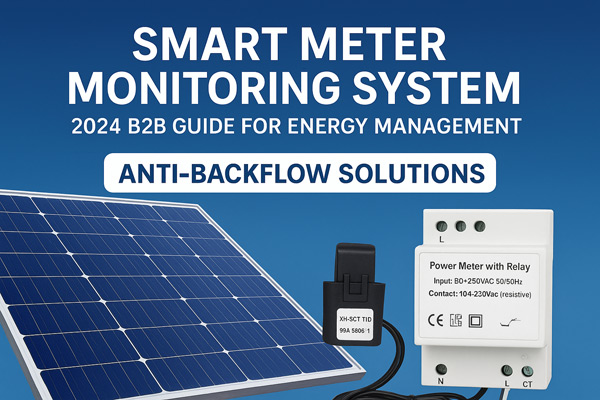1. Introduction: Solar Energy’s Shift Toward Smarter Control
As solar adoption accelerates across the globe, balcony PV systems and small-scale solar-plus-storage solutions are transforming residential and commercial energy management.
According to Statista (2024), distributed PV installations in Europe grew by 38% year-on-year, with over 4 million households integrating plug-and-play solar kits. However, one critical challenge persists: backflow of electricity into the grid during low-load conditions, which can cause safety issues and grid instability.
For system integrators, OEMs, and B2B energy solution providers, the demand for anti-reverse-flow metering is rapidly rising — enabling safer operation and smarter energy optimization.
2. Market Trends: From “Balcony PV” to Grid-Aware Systems
In Germany and the Netherlands, small solar systems are now part of city energy networks. A 2024 IEA report shows that over 60% of new residential PV systems include monitoring devices or smart meters for grid interaction.
Meanwhile, Asian and Middle Eastern markets are seeing an emerging demand for anti-backflow meters in hybrid solar and storage systems, where grid export control is essential to comply with local energy policies.
| Region | Market Trend | Key Technical Demand |
|---|---|---|
| Europe | High-density balcony PV, smart metering integration | Anti-reverse metering, Wi-Fi/RS485 communication |
| Middle East | Hybrid PV + Diesel systems | Load balancing and data logging |
| Asia-Pacific | Fast-growing OEM/ODM manufacturing | Compact, DIN-rail energy monitors |
3. The Role of Anti-Reverse-Flow Energy Meters
Traditional electricity meters are designed primarily for billing — not for dynamic load management.
In contrast, anti-backflow meters focus on real-time energy monitoring, bidirectional current detection, and integration with controllers or inverters.
Key Features of Modern Smart Anti-Backflow Meters:
-
Fast Data Sampling: Voltage/current updated every 50–100ms for instant load feedback.
-
Dual Communication Options: RS485 (Modbus RTU) and Wi-Fi (Modbus TCP/Cloud API).
-
Compact DIN-Rail Design: Fits easily into limited spaces in PV distribution boxes.
-
Real-Time Phase Diagnostics: Detects wiring errors and guides installers.
-
Cloud-Based Energy Analytics: Enables installers and OEM partners to remotely monitor system health.
Such devices are critical for balcony PV, hybrid solar-storage systems, and microgrid projects where reverse energy flow must be prevented while maintaining visibility into total energy consumption and generation.
4. Integration with Solar & IoT Platforms
Anti-backflow meters are now designed for easy integration with solar inverters, BMS (Battery Management Systems), and EMS (Energy Management Systems) through open protocols such as Modbus, MQTT, and Tuya Cloud.
For B2B clients, this means faster deployment, simpler customization, and the ability to white-label the solution for their own product lines.
Example Integration Use Case:
A solar installer integrates a Wi-Fi power meter with clamp sensors into a home PV inverter system.
The meter transmits real-time generation and consumption data to the cloud, while automatically signaling the inverter to limit export when household consumption is low — achieving seamless anti-backflow control.
5. Why Anti-Backflow Metering Matters for OEM & B2B Clients
| Benefit | Value for B2B Clients |
|---|---|
| Safety & Compliance | Meets regional anti-export grid requirements. |
| Plug-and-Play Deployment | DIN-rail + clamp sensors = simplified installation. |
| Customizable Protocols | Modbus/MQTT/Wi-Fi options for OEM flexibility. |
| Data Transparency | Enables smart monitoring dashboards. |
| Cost Efficiency | Reduces maintenance and retrofitting costs. |
For OEM/ODM manufacturers, integrating anti-backflow technology into smart meters adds market competitiveness and compliance readiness for European and North American grid standards.
6. FAQ – What B2B Buyers Ask Most
Q1: What is the difference between a billing smart meter and a smart anti-backflow meter?
→ Billing meters focus on revenue-grade accuracy, while anti-backflow meters emphasize real-time monitoring and grid export prevention.
Q2: Can these meters work with solar inverters or storage systems?
→ Yes, they support open communication protocols (Modbus, MQTT, Tuya), making them ideal for solar, storage, and hybrid microgrid applications.
Q3: Do I need certification for OEM integration into EU markets?
→ Most OEM-ready meters meet CE, FCC, or RoHS requirements, but you should verify project-specific compliance.
Q4: How can I customize these meters for my brand?
→ Many suppliers provide white-label, packaging, and firmware customization for B2B buyers with minimum order quantities (MOQ).
Q5: How does anti-reverse metering enhance ROI?
→ It minimizes grid penalties, improves inverter performance, and optimizes on-site energy use — directly shortening payback periods for solar projects.
7. Conclusion: Smarter Energy Starts with Safer Metering
As solar and storage systems continue to expand across residential and commercial sectors, smart anti-backflow energy meters are becoming a cornerstone technology for energy management.
For B2B partners — from distributors to system integrators — adopting these solutions means offering safer, smarter, and more compliant solar systems to end users.
OWON Technology, as a trusted OEM/ODM manufacturer in the IoT and energy monitoring field, continues to provide customizable Wi-Fi energy meters and anti-backflow solutions that help clients accelerate their smart energy strategies worldwide.
Post time: Oct-11-2025
